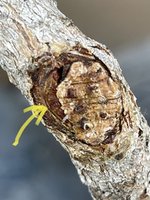bonhe
Masterpiece
More than 2 weeks under the Summer heat, the graft is still looking goodThis morning, I worked on this Kakuju pine. I will show you another way to approach this technique.
Before
View attachment 381214
After pruning, removing the wires and some old needles, I removed 2 unnecessary big branches .
The 1st wound
View attachment 381227
Because this wound is right in the big trunk, it is not good to use the grafting tape to keep the skin in place! I decided to use Crazy Glue instead of tape!
View attachment 381233
The problem which may appear with glue is that the skin may not attached well to the wound bottom. Because of that, it may create the gap between the skin and the wound bottom. This gap will hold the sap excreted from the wound, which may turn out into the “sapoma “ . This sapoma may prevent the healing process of the skin graft, lead to a failure!
To avoid of sapoma, I made multiple tiny holes on the skin . I have this dental tool which works well for this purpose.
View attachment 381228 View attachment 381229
The skin with multiple puncture wounds through and through!
View attachment 381230
After cut the skin to fit into the wound area, I placed it into the wound. One hand used the flat blade to press the skin down, while another hand squeezed a little Crazy glue into the border of the skin and the wound. The glue was just sucked in easily.
View attachment 381231
After one minute, the blade was removed. The skin still stayed well in place !
View attachment 381232
In 5 minutes, as I expected, there were some oozing coming out from some tiny holes !
View attachment 381234 View attachment 381235
Thụ Thoại

Thụ Thoại



















